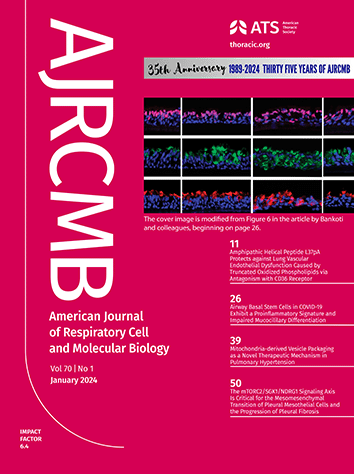CSP7 Protects Alveolar Epithelial Cells by Targeting p53-Fibrinolytic Pathways During Lung Injuries.
IF 5.9
2区 医学
Q1 BIOCHEMISTRY & MOLECULAR BIOLOGY
American Journal of Respiratory Cell and Molecular Biology
Pub Date : 2024-09-13
DOI:10.1165/rcmb.2023-0453oc
引用次数: 0
Abstract
Impaired alveolar epithelial regeneration in patients with idiopathic pulmonary fibrosis (IPF) and chronic obstructive pulmonary disease (COPD) is attributed to telomere dysfunction in type II alveolar epithelial cells (A2Cs). Genetic susceptibility, aging, and toxicant exposures, including tobacco smoke (TS), contribute to telomere dysfunction in A2Cs. Here we investigated whether improvement of telomere function plays a role in CSP7-mediated protection of A2Cs against ongoing senescence and apoptosis during bleomycin (BLM)-induced pulmonary fibrosis (PF) as well as alveolar injury caused by chronic TS exposure. We found a significant telomere shortening in A2Cs isolated from IPF and COPD lungs in line with other studies. These cells showed increased p53 in addition to its post-translational modification with induction of activated caspase-3 and β-galactosidase, suggesting a p53-mediated loss of A2C renewal. Further, we found increased expression of SIAH-1, a p53-inducible E3 ubiquitin ligase known to down-regulate telomere repeats binding factor 2 (TRF2). Consistent with the loss of TRF2 and upregulation of TRF1, telomerase reverse transcriptase (TERT) was downregulated in A2Cs. A2Cs from fibrotic lungs of mice either repeatedly instilled with BLM or isolated from chronic TS exposure-induced lung injury model showed reduced telomere length along with induction of p53, PAI-1, SIAH1 and TRF1 as well as loss of TRF2 and TERT, which were reversed in wild-type mice after treatment with CSP7. Interestingly, PAI-1-/- mice, or those lacking microRNA-34a expression in A2Cs, resisted telomere dysfunction, while uPA-/- mice failed to respond to CSP7 treatment, suggesting p53-microRNA-34a feed-forward induction and p53-uPA pathway contributes to telomere dysfunction.CSP7通过靶向肺损伤过程中的p53-纤维蛋白溶解途径保护肺泡上皮细胞
特发性肺纤维化(IPF)和慢性阻塞性肺病(COPD)患者的肺泡上皮再生功能受损,是由于II型肺泡上皮细胞(A2Cs)的端粒功能障碍造成的。遗传易感性、衰老和毒物暴露(包括烟草烟雾(TS))导致了肺泡上皮细胞端粒功能障碍。在此,我们研究了端粒功能的改善是否在 CSP7 介导的保护 A2Cs 免受博莱霉素(BLM)诱导的肺纤维化(PF)以及慢性 TS 暴露引起的肺泡损伤过程中的衰老和凋亡中发挥作用。我们发现,从 IPF 和 COPD 肺中分离出的 A2Cs 中存在明显的端粒缩短现象,这与其他研究结果一致。这些细胞显示出 p53 的增加,以及其翻译后修饰与活化的 caspase-3 和 β-半乳糖苷酶的诱导,这表明 p53 介导的 A2C 更新损失。此外,我们还发现SIAH-1的表达增加,SIAH-1是p53诱导的E3泛素连接酶,已知可下调端粒重复结合因子2(TRF2)。与TRF2的缺失和TRF1的上调相一致,端粒酶逆转录酶(TERT)在A2Cs中也出现了下调。反复灌注 BLM 或从慢性 TS 暴露诱导的肺损伤模型中分离的小鼠纤维化肺中的 A2Cs 显示端粒长度减少,同时诱导 p53、PAI-1、SIAH1 和 TRF1 以及 TRF2 和 TERT 的缺失。有趣的是,PAI-1-/-小鼠或那些在A2Cs中缺乏microRNA-34a表达的小鼠能抵抗端粒功能障碍,而uPA-/-小鼠则对CSP7处理没有反应,这表明p53-microRNA-34a前馈诱导和p53-uPA途径导致了端粒功能障碍。
本文章由计算机程序翻译,如有差异,请以英文原文为准。
求助全文
约1分钟内获得全文
求助全文
来源期刊
CiteScore
11.20
自引率
3.10%
发文量
370
审稿时长
3-8 weeks
期刊介绍:
The American Journal of Respiratory Cell and Molecular Biology publishes papers that report significant and original observations in the area of pulmonary biology. The focus of the Journal includes, but is not limited to, cellular, biochemical, molecular, developmental, genetic, and immunologic studies of lung cells and molecules.

 求助内容:
求助内容: 应助结果提醒方式:
应助结果提醒方式:


